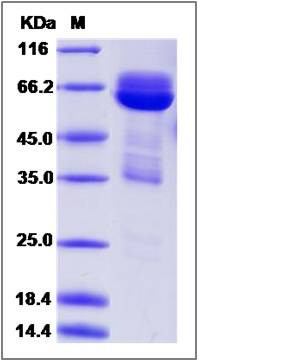Rat CADM3 / NECL1 / IGSF4B Protein (Fc Tag)
CADM3, Igsf4b, Necl1
- 100ug (NPP2985) Please inquiry
| Catalog Number | P80220-R02H |
|---|---|
| Organism Species | Rat |
| Host | Human Cells |
| Synonyms | CADM3, Igsf4b, Necl1 |
| Molecular Weight | The recombinant rat CADM3/Fc is a disulfide-linked homodimer. The reduced monomer comprises 547 amino acids and has a predicted molecular mass of 60.5 kDa. The apparent molecular mass of the protein is approximately 61 kDa in SDS-PAGE under reducing conditions due to glycosylation. |
| predicted N | Asn 23 |
| SDS-PAGE |  |
| Purity | > 85 % as determined by SDS-PAGE |
| Protein Construction | A DNA sequence encoding the rat CADM3 (Q1WIM3) (Met1-His328) was expressed with the Fc region of human IgG1 at the C-terminus. |
| Bio-activity | |
| Research Area | Cancer |Oncoprotein & suppressor & biomarker |Tumor biomarker |Tumor Suppressor |Other in Tumor suppressor |
| Formulation | Lyophilized from sterile PBS, pH 7.4. 1. Normally 5 % - 8 % trehalose and mannitol are added as protectants before lyophilization. Specific concentrations are included in the hardcopy of COA. |
| Background | Cell Adhesion Molecules (CAMs) are proteins located on the cell surface involved with the binding with other cells or with the extracellular matrix (ECM) in the process called cell adhesion. These proteins are typically transmembrane receptors and are composed of three domains: an intracellular domain that interacts with the cytoskeleton, a transmembrane domain, and an extracellular domain that interacts either with other CAMs of the same kind (homophilic binding) or with other CAMs or the extracellular matrix (heterophilic binding). Cell adhesion molecule 3, also known as Immunoglobulin superfamily member 4B, CADM3, and NECL1, is a neural tissue-specific immunoglobulin-like cell-cell adhesion molecule which has Ca(2+)-independent homo- or heterophilic cell-cell adhesion activity and plays an important role in the formation of synapses, axon bundles and myelinated axons. Isoform 1 of CADM3 is expressed mainly in adult and fetal brain. Isoform 2 of CADM3 is highly expressed in adult brain and weakly expressed in placenta. In brain, Isoform 2 is highly expressed in cerebellum. CADM3 is involved in the cell-cell adhesion. It has both calcium-independent homophilic cell-cell adhesion activity and calcium-independent heterophilic cell-cell adhesion activity with IGSF4, PVRL1 and PVRL3. The interaction with EPB41L1 may regulate structure or function of cell-cell junctions. CADM3 may act as a tumor suppressor in glioma and loss of it in glioma may be caused by histone deacetylation. |
| Reference |
